#sonoran green toad
Note
Hello! Since March 8th is International Women’s Day, I was wondering if you might share with us some females from various species? (Since the more vibrant males tend to get the spotlight lol)
International Women’s Day!!!
Yes yes yes! With many animals, the females are more impressively large or more colorful than the males. Let's have a look at some impressive and amazing females...

(Southern) Green Anaconda (Eunectes murinus), female, family Boidae, Ecuador
With many snakes, the females get to be much larger than the males. Female Anacondas grow to be the heaviest snakes in the world, as up to 97.5 kg (214 lb 15 oz).
Though reports have claimed that Green Anacondas can grow up to over 30 ft long, the longest ever ACTUALLY measured was about 19 ft. long.
photograph by Alejandro Arteaga
Advance Wildlife Education

Brahminy Blindsnake aka Flowerpot Snake (Indotyphlops braminus), family Typhlopidae, found in tropical and subtropical areas around the world
This snake is native to somewhere along the Indian Ocean, possibly somewhere in SE Asia or coastal Africa.
The fossorial (burrowing) snake feeds mainly on the larvae, pupae, and eggs of ants and termites.
All known specimens of this snake have been female. They reproduce through parthenogenesis (asexually).
photograph via: UGA Coastal Ecology Lab
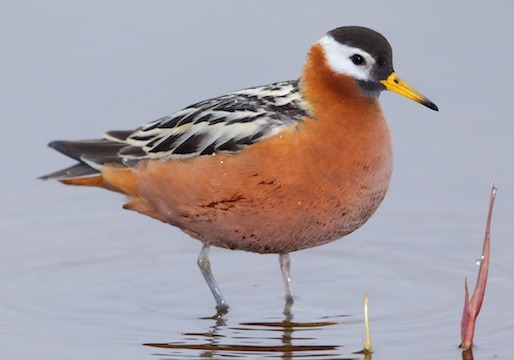
Red Phalarope (Phalaropus fulicarius), female, family Scolopacidae, order Charadriiformes, near Barrow, Alaska, USA
Female Phalaropes are larger and more colorful than the males. They court the males and defend the nest site. The males incubate the eggs, and raise the chicks.
photograph by Mark A. Chappell
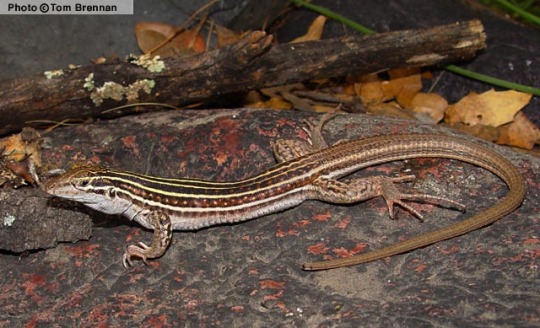
Sonoran Spotted Whiptail (Aspidoscelis sonorae), females, family Teiidae, Arizona
This is another all female parthenogentic species.
There are other closely relates species, other whiptails and racerunners, that are also all female populations. Some of them are completely parthenogenic, and some combine parthenogenesis with sexual input from closely related species or populations nearby.
photograph by Tom Brennan
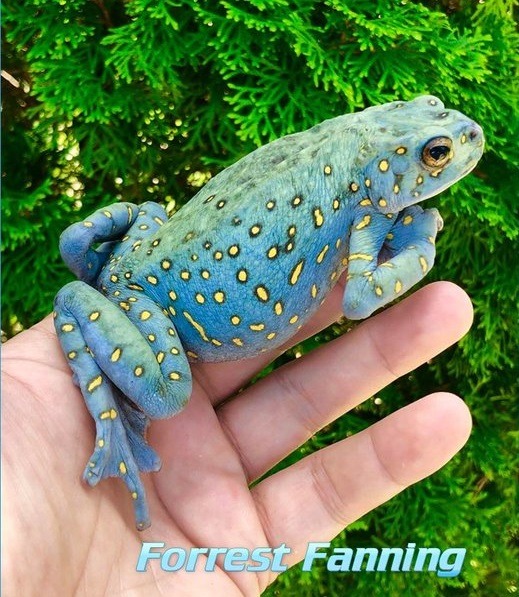
photograph by Forrest Fanning

photograph by Giuseppe Mazza
Asian Yellow-spotted Climbing Toad (Rentapia hosii), females, family Bufonidae, found in SE Asia
The females of this species are large, gorgeous, ornate frogs, while the males are much smaller and much less colorful.
#frog#toad#amphibian#snake#anaconda#reptile#phalarope#bird#animals#nature#whiptail#lizard#blind snake#international women's day
506 notes
·
View notes
Note
Please and thank you: tell me something about the desert, I’ve never met one, but would like to. Something big or small, just something lovely?
in the sonoran desert, when it rains during the monsoon, the desert petrichor mingles with the exudates of the creosote/chaparral and makes the most incredible scent. i smelled in when i visited in 2021 and it made me cry instantly
in phoenix, the introduced mediterranean gecko (Hemidactylus turcicus) has become incredibly common, and most of my childhood lizard memories are either of encounters with them, or with the tree lizard (Urosaurus ornatus). the geckos are really hidey and stay in the shadows and come out at night (you'll see them a lot around lamps eating the attracted insects), but the tree lizards are showy, and they love to dash around on cinderblock walls and soak up the sun, and do pushups at other tree lizards (males have a bright blue patch on their throat). until recently tree lizards were classified as part of a larger Iguanidae family, but were recently re-classified into the Phrynosomatidae family, which also includes the horned lizards* and spiny lizards, and you can see the relation between them in the shape of the top of their skull around the parietal eye. also i just found out that the oldest known member of this family, excavated in Mongolia, has been named Desertiguana, not to be confused with the desert iguana (Dipsosaurus dorsalis) which is found in the sonoran desert (& bordering deserts)
another incredible thing about the desert are tadpole shrimp (Triops) and spadefoot toads (genus Spea and Scaphiopus). during the monsoon these'll pop out of the dust and spend the next week or so fucking in the very temporary pools, and lay their eggs. the shrimp eggs will not hatch (and iirc need to be dried out before they will hatch) and will settle into swiftly drying mud. the spadefeet eggs will hatch and then mature incredibly swiftly, and the little toads will dig into the drying dirt and cover themselves with a membrane that will keep them moist until the next rains come.
also the sonoran desert at sunrise is just incredible, visually, and also aurally. all of the many many species of bird found in the desert sending out their symphonic cacophany into the morning. warbling cactus wren, whistling thrasher's and creaking grackles and the little cheep of the verdin (a little green-grey bird with a bright yellow head that's often found on the palo verde, which has green bark and bright yellow flowers). in some areas you might see gila woodpeckers nesting in holes in saguaros, and in the phoenix area a population of introduced peach-faced lovebirds has become established, and occupy seemingly a niche that nothing else was in, and sometimes you might see them amongst the cactopodes also.
*these fuckers eat ants and are so specialized in eating ants that they have a compound in their blood to neutralize formic acid and if they don't eat enough ants that need neutralized the compound builds up and poisons them. also some species can shoot blood out of their eyes. please don't make them do this
8 notes
·
View notes
Photo
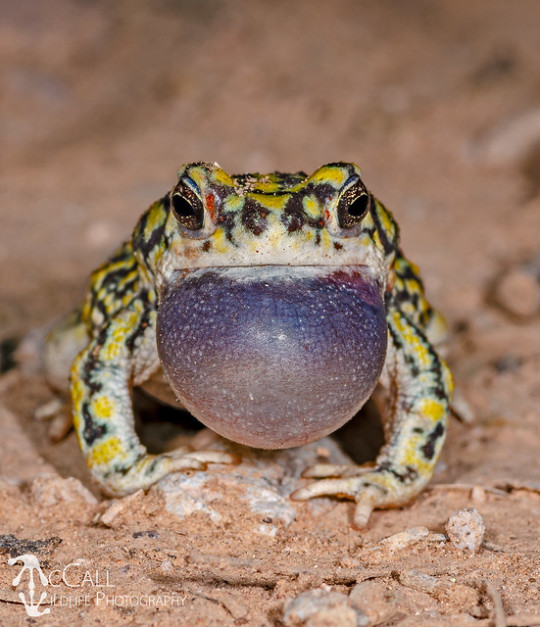
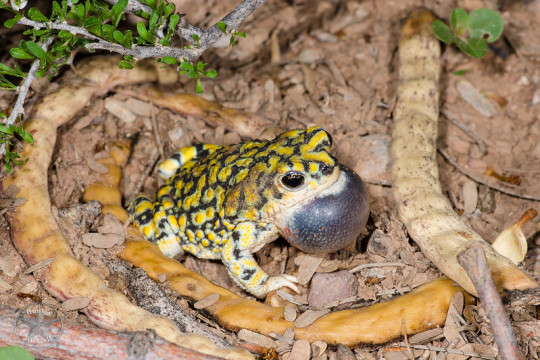
Here we see two Sonoran green toads [Anaxyrus retiformis] calling for mates in Maricopa County, Arizona. These teeny toads can be found from south-central Arizona to central Sonora in Mexico. They typically inhabit dry valleys and grasslands, and breed following the summer monsoon rains in July and August. Images by McCall Wildlife Photography.
412 notes
·
View notes
Text

today’s funky frog of the day is: bufo retiformis! commonly known as sonoran green toads, they are found in northern mexico and the southwestern united states. typical habitats are arid and semi-arid plains with grass, creosote bush, mesquite, and saguaro. they are nocturnal, and little is known about their behavior outside of the breeding season. they may live underground and only emerge during the wet conditions, and it is unclear whether or not they estivate. they breed from july to august, and the male’s call resembles "the buzzer on an electric alarm clock.” herpetologists assume these frogs feed on beetles, ants, moths, and winged termites, and they are expected to live for around 10 years.
412 notes
·
View notes
Photo

Animals of the Sonoran Desert! Day 26: Sonoran Green Toad!
Ink, 6 x 6 inches
JoJo Seames, 2021
#october ink the desert#sonoran green toad#toad#ink#ink drawing#drawing#art#illustration#jojo seames
16 notes
·
View notes
Text

The boys are
in love
#frogs#frog#australian green tree frog#art frog#dumpy tree frog#frog art#frog boye#frogcore#froggo#froggy#frogpost#frogposting#frong#froooooog#froggie#toadblr#toads#toad#european common toad#sonoran green toad#gay pride#gay#gay couple#gay love#lgbt pride#lgbt#lgbtq community
296 notes
·
View notes
Photo

Sonoran Green Toad, Bufo retiformis, SE Arizona
photograph by Dick Bartlett (w/ permission)
245 notes
·
View notes
Text
WHELP a college friend needs to rehome some pet toads so guess I’m taking in some Sonoran green toads that I know nothing about so I’ll be researching a lot tonight
51 notes
·
View notes
Note
Oh my gah, I love your comics and with your love for critters I gotta ask... what's your fav critter from Mexico?
thank you so much!!!!!!
i'm afraid i've never been to mexico, so i can't speak from experience, but i have ALWAYS wanted to go!! there's so many gorgeous birds down south (like Green Jays or pyrrhuloxia), and because it's warmer, bugs get big!!! if you happen to see a sonoran giant centipede, or a big fat Megasoma elaphas rhinoceros beetle, or even (far enough south and with a great deal of luck) THE Hercules beetle, Dynastes hercules, i would LOVE to hear all about it. and of course there's so many little bugs too! and fun herps!!!! so many snakes and lizards and toads and salamanders and newts.
6 notes
·
View notes
Text

Sonoran Green Toad (𝘈𝘯𝘢𝘹𝘺𝘳𝘶𝘴 𝘳𝘦𝘵𝘪𝘧𝘰𝘳𝘮𝘪𝘴), male calling, family Bufonidae, Arizona, USA
photograph by Ross Maynard
433 notes
·
View notes
Photo

#toad#animal#arizona#macro#photographers on tumblr#textless#amadee ricketts#desert museum#sonoran desert toad#face#eye#green
173 notes
·
View notes
Photo

This pretty little lady is a Sonoran green toad [Anaxyrus retiformis], a species native to the Sonoran Desert, between Arizona and Mexico. These toads are most often seen on humid nights, especially following seasonal summer rain. Image by Bill Hughes.
297 notes
·
View notes
Text
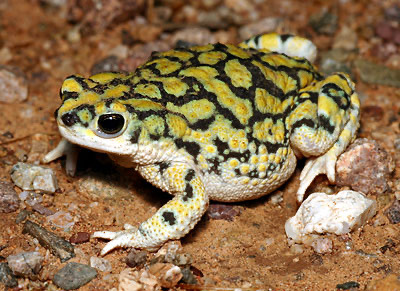
today’s funky frog of the day is: anaxyrus retiformis! commonly known as the sonoran green toad, they are found in northern mexico and the southwestern united states. their typical habitats include arid and semi-arid plains with grass, creosote bush, mesquite, and saguaro. they are nocturnal, and little is known of their behavior outside of breeding season. they are thought to be fossorial, and it is not clear whether or not they estivate. breeding takes place in july and august. the males appear at breeding sites one to two days after heavy rain has fallen and call from low vegetation to attract females. their call has been described as a “buzzer on an electric alarm clock.” they usually live for about 10 years, although in some cases, they may live up to 20.
240 notes
·
View notes
Text
It’s National Frog Month!

It’s this time of year that nighttime drives in the car with the windows down take on a whole new song. A beautiful, harmonious, chirping song. Native frog species are emerging, singing their springtime serenade to welcome the season, and consequently-- National Frog Month. This April, we want to celebrate Frog Month by talking about the native amphibious friends occurring naturally in our own backyards, as well as some of the more exotic species that you can visit at the Chattanooga Zoo.
Locally, the warm weather is bringing out species like Green Tree Frogs, the American Bullfrog, and the Eastern Spadefoot. At night, you probably hear the high pitched call of the appropriately named Spring Peeper. In all, Tennessee is home to 21 individual species of frogs and toads, each playing an important role in the local ecosystem. Frogs are integral to keeping insect populations at bay, eating bugs like pesky mosquitos and flies. Frogs and toads are also what is called an “indicator species”. Because frogs have extremely absorbent skin, they require clean and habitable water to survive. Frog populations are a great indicator of the health of our waterways. When frog numbers decline, water pollution could be a factor. Likewise, when populations are healthy and thriving, it is a good indication that the level of pollutants are low.
Just as local frog species are important (and very interesting!), frogs around the world are important to our environment and to the ecosystems in which they reside. At the Chattanooga Zoo, you can step into the frog’s world and see their habitat up close and personal through their enclosures. The Zoo houses species like the Amazon Milk Frog, who’s specially adapted toe-pads can hold up to 14 times their weight. We’re also home to the African Bullfrog, and Sonoran Desert Toad. You can even view brightly-colored Poison Dart Frogs hopping about their enclosure, coexisting peacefully with the Bushmaster-- a large venomous viper found in the Amazon River basin.

As Spring enters Chattanooga, we hope that you roll your windows down and pause to enjoy the frogs’ song. Happy National Frog Month!
2 notes
·
View notes
Text
frog of the day :)
anaxyrus retiformis, common name: sonoran green toad

(Image source)
Habitat: Arid and semi arid plains with a decent amount of grasses and plants
Found in: the USA and Mexico
#toads#true toads#FAMILY: Bufonidae (true toads)#anaxyrus retiformis#GENUS: anaxyrus (North american toads)#north american toads#frog of the day
4 notes
·
View notes
Photo

Sonoran Green Toad 💚 📸 Sapo Verde de Sonora 🏜️ 🧬 Anaxyrus retiformis 🔬 📍Hermosillo, Sonora. Mx 🇲🇽 Este fantasma, endémico del Desierto sonorense se limita a ciertas áreas restringidas del centro de Sonora y sur de Arizona 🌵 Mantienen poblaciones limitadas a micro hábitats especificos, por lo que son MUY difíciles de encontrar, debido a esto los estudios son tan escasos, que no se ha podido establecer alguna protección especial de órganos nacionales o internacionales 🌐 Se encuentra en estado de preocupación menor, pero es por la pérdida de hábitat, no por tener mucha información de la especie 🤔 Como encontramos uno? Momento y lugar a adecuados y MUCHA SUERTE 🤷🏻♂️ los biólogos con los que iba se volvieron LOCOS 😂 .... #toad #amphibian #Mexico #wildlifephotography #animal_captures #animals_in_world #splendid_animals #animal_fanatics #fotosnaturalezaMX #wildlife #naturephotography #reptilesofInstagram #reptilesofinsta #natgeo #momentonatgeo #reptilephotography #natgeoyourshot #AnimalElite #bns_nature #discoverwildlife #wildlifeonearth #BBCWildlifePOTD #raw_herpetology #natureInFocus #raw_wildlife #WildlifeiG #wildlifeDairy #nb_nature_brilliance #fotografia #naturaleza (en Hermosillo, Sonora) https://www.instagram.com/p/CX6sQ_JvS2U/?utm_medium=tumblr
#toad#amphibian#mexico#wildlifephotography#animal_captures#animals_in_world#splendid_animals#animal_fanatics#fotosnaturalezamx#wildlife#naturephotography#reptilesofinstagram#reptilesofinsta#natgeo#momentonatgeo#reptilephotography#natgeoyourshot#animalelite#bns_nature#discoverwildlife#wildlifeonearth#bbcwildlifepotd#raw_herpetology#natureinfocus#raw_wildlife#wildlifeig#wildlifedairy#nb_nature_brilliance#fotografia#naturaleza
0 notes